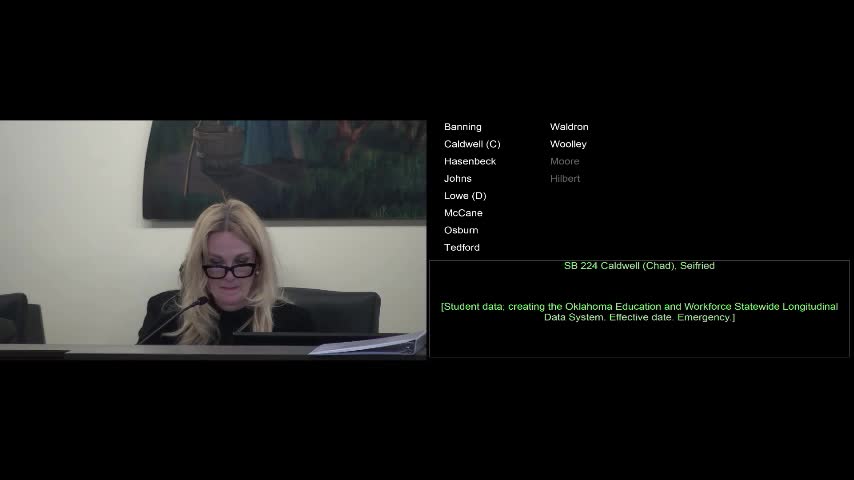Committee advances Oklahoma Education and Workforce Efficiency Data System amid privacy questions
April 07, 2025 | 2025 Legislature OK, Oklahoma
This article was created by AI summarizing key points discussed. AI makes mistakes, so for full details and context, please refer to the video of the full meeting. Please report any errors so we can fix them. Report an error »

Representative Caldwell presented Senate Bill 224 to create the Oklahoma Education and Workforce Efficiency Data System, a centralized clearinghouse designed to link education, workforce and higher-education data to help track program effectiveness and long-term outcomes.
Representative Caldwell told the committee the system would reduce inefficiencies from siloed datasets and said governance would include officials from state agencies and a data privacy expert.
Why it matters: proponents said a centralized system will enable better evaluation of education investments and workforce outcomes; critics and some committee members expressed concerns about data privacy, access controls, and the potential for misuse.
Privacy and access questions
Representative Willy asked how the bill would prevent breaches or leaks when data moves across agencies. Representative Caldwell replied that the system would, in his view, provide enhanced protections compared with current siloed systems because governance and controlled access would be centralized and multiple agencies would participate in oversight.
Members asked whether parents could opt out; Caldwell said the bill does not change present opt-out rights and that any existing parental opt-outs would remain in place.
Who would access the data
Representative Tedford asked whether the identities of approved external partners and entities that would receive controlled access to the data would be publicly disclosed. Caldwell said core state entities would be known and that external partners would be selected via procurement (RFP) and overseen through the governance council; he said protections tied to FERPA and state statutes would apply.
Vote and next steps
The committee recorded a 7-3 vote in favor of the measure; the speaker declared the bill passed through committee. The transcript shows the committee discussed the governance structure and intended RFP process for external partners but did not list specific vendor names.
Ending
Supporters said the system would improve the state's ability to measure program impact and target resources; critics urged continued attention to privacy protections, transparency on accessing partners and opt-out mechanics.
Representative Caldwell told the committee the system would reduce inefficiencies from siloed datasets and said governance would include officials from state agencies and a data privacy expert.
Why it matters: proponents said a centralized system will enable better evaluation of education investments and workforce outcomes; critics and some committee members expressed concerns about data privacy, access controls, and the potential for misuse.
Privacy and access questions
Representative Willy asked how the bill would prevent breaches or leaks when data moves across agencies. Representative Caldwell replied that the system would, in his view, provide enhanced protections compared with current siloed systems because governance and controlled access would be centralized and multiple agencies would participate in oversight.
Members asked whether parents could opt out; Caldwell said the bill does not change present opt-out rights and that any existing parental opt-outs would remain in place.
Who would access the data
Representative Tedford asked whether the identities of approved external partners and entities that would receive controlled access to the data would be publicly disclosed. Caldwell said core state entities would be known and that external partners would be selected via procurement (RFP) and overseen through the governance council; he said protections tied to FERPA and state statutes would apply.
Vote and next steps
The committee recorded a 7-3 vote in favor of the measure; the speaker declared the bill passed through committee. The transcript shows the committee discussed the governance structure and intended RFP process for external partners but did not list specific vendor names.
Ending
Supporters said the system would improve the state's ability to measure program impact and target resources; critics urged continued attention to privacy protections, transparency on accessing partners and opt-out mechanics.
View full meeting
This article is based on a recent meeting—watch the full video and explore the complete transcript for deeper insights into the discussion.
View full meeting
